Out of two movies dealing with the multiverse this year, nobody could have predicted A24’s Everything Everywhere All at Once (EEAO, for the sake of brevity) would be the more critically acclaimed of the two. After all, the indie film had no superheroes(unless you count Michelle Yeoh, which I definitely do), grandiose computer-generated (CG) scenes, or big-name directors. Despite that, the unique filmmaking style combined with a mother-daughter story that dealt with generational trauma catapulted EEAO to the top of must-watch lists for 2022. It’s both incredibly emotional and downright hilarious, precariously balancing an important narrative with VFX hijinks that never seem to stop coming.
While EEAO and Doctor Strange in the Multiverse of Madness use the multiverse as a setting, the latter’s budget was exorbitantly higher. Marvel’s reported $200 million film dwarfed EEAOs budget of $25 million, but it’s the smaller budget film that’s raking in the praise, a fact that Jamie Lee Curtis will not let you forget. Then again, making the most of any budget is what the creative duo known as “Daniels” are known for. Daniel Scheinert and Daniel Kwan are notorious for their DIY filmmaking style, making their biggest mark on the industry with this latest release. Together with a small team of similarly-resourceful VFX artists, the duo was able to make their vision come true with very little budget for a film of that size.
As it stands now, EEAO has made $93 million worldwide, recouping almost four times what the movie cost to make. So while it’s unlikely that big superhero films will be made with smaller budgets in the future, it does prove you don’t need outsized budgets to make visually-stunning films.
From Music Videos to Feature Films
Before EEAO and Daniels’ other movie, Swiss Army Man with Daniel Radcliffe (another Daniel), the pair got their start directing music videos. Not only did it allow them to develop their skills as filmmakers, but it taught them a lot about making the most of any situation. Kwan’s VFX background gelled with Scheinert’s less-precise improv style of filmmaking — he studied comedy and was part of a sketch troupe in college. That resulted in a lot of practical effects and outlandish ideas that weren’t always met with the same enthusiasm from artists. In an interview with Pitchfork, Daniels talked about how The National turned them down after suggesting the band would be killed off in the video. Still, enough bands showed interest that they were able to accumulate a body of work.
Bands like The Shins, Manchester Orchestra, Foster the People, and Passion Pit were eager to take on Daniels’ unique brand of weirdness. And their wish of killing off a band in a video was eventually granted. In Foster the People’s Houdini video, the stage lights fall on the band, killing off all members. However, they’re still able to perform thanks to full-bodysuit-wearing stagehands that puppet the band members. The concept is out there, but the narrative is clear.
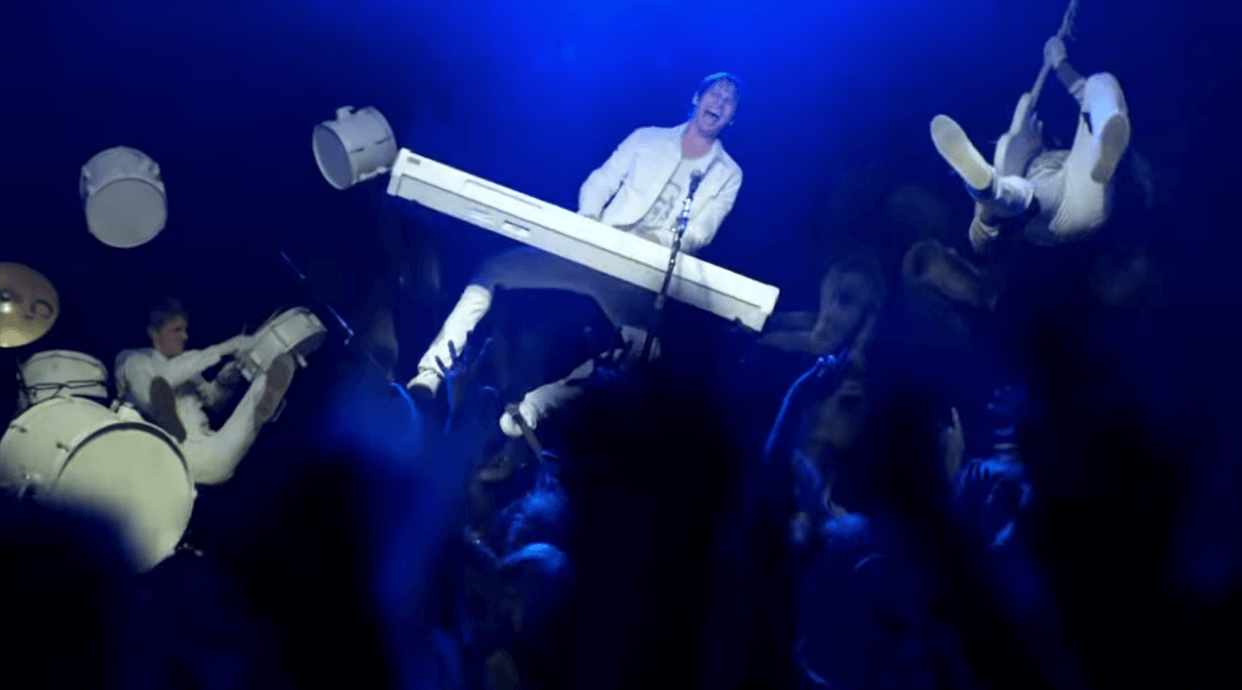 Foster the People floating on stage mid-performance. Image via Foster the People (YouTube).
Foster the People floating on stage mid-performance. Image via Foster the People (YouTube).
While effects are minimal, the part where the band is floating along with their instruments in slow motion above the stage is the highlight of the video. Another example: In Manchester Orchestra’s “Simple Math,” practical effects add surrealism to a man’s memories as his life flashes before his eyes while flying through a windshield. And in DJ Snake and Lil Jon’s “Turn Down for What,” the uninhibited nature of the song is reflected in the special effects, matching the chaos of the lyrics with equally chaotic effects, which you can see for yourself.
Daniels hasn’t done a music video since Manchester Orchestra’s “The Sunshine” back in 2017. However, music videos aren’t all they’re known for. Signed to Prettybird, a hybrid production company, Daniels also took on directing commercials. They’ve worked for big names like Toyota, Levi’s, Apple, and even Nike, where they made an ad that featured Serena Williams, Kevin Durant, Nyjah Huston, and Neymar Jr., to name a few. Of course, the Nike ad is inspirational, but Daniels’ use of humor brings levity to the “Just Do It” mantra. The ad satirizes inspirational sports commercials by showing athletes doing increasingly unsafe and unreal activities like grinding a 100+-stair rail, which is believably terrifying thanks to special effects.
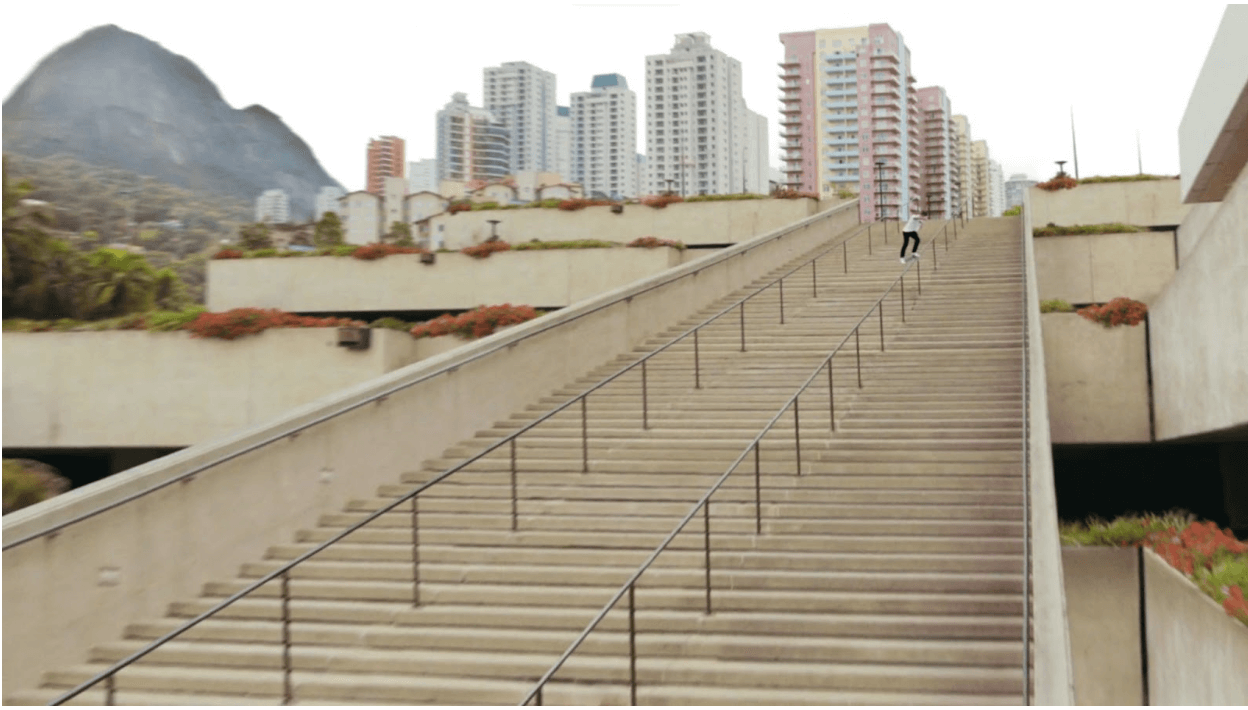 Nyjah Huston grinding an impossibly-long rail for Nike’s Unlimited You commercial. Image via Prettybird.
Nyjah Huston grinding an impossibly-long rail for Nike’s Unlimited You commercial. Image via Prettybird.
In an interview with our very own Nate Watkin for the Creatives Offscript podcast, Ali Brown, the president of Prettybird, spoke about Daniels’ unique vision and creative use of budget. “There was nothing imitative about their work. They just, from day one to day now, everything they do is so clearly theirs, and it doesn’t matter what the budget is, there’s no apologies ever connected with their work,” Brown said. “What they do is what they do, and they do it so beautifully and so uniquely that I think they’re the best example of just constantly blowing me away since day one.”
Unorthodox VFX Team Made it Happen
A lot of the buzz surrounding the film, at least in film circles, is due to the shockingly-short list of VFX artists that worked on the film. Zak Stoltz, the visual effects supervisor on the film, mentioned that five people, including him, did 80% of the film’s 500 VFX shots. That comes out to about 80 shots per person. That’s what Daniels wanted; a small team they could collaborate with.
After outsourcing VFX to a studio for Swiss Army Men, Daniels’ preferred method of editing and post-production didn’t match how post-production studios work. So for this film, they envisioned themselves working under one roof alongside the film’s editor and the small VFX team. Working hands-on was what they were used to, with Kwan telling Wired, “It was incredibly fulfilling for us because we love to be in there in the weeds as well because that’s just how we’ve always done things.” Even back in their music video days, they would all work together. According to Stoltz, when doing post-production on the Tenacious D music video, they slept and worked in the same room.
 Daniels, Zak Stoltz, and Ben Brewer also worked on this Tenacious D music video, which was intentionally supposed to look like a rough cut. Image via Tenacious D (YouTube).
Daniels, Zak Stoltz, and Ben Brewer also worked on this Tenacious D music video, which was intentionally supposed to look like a rough cut. Image via Tenacious D (YouTube).
Unfortunately, because of the pandemic, that meant their idea of all of them working together wasn’t meant to be. In a stroke of luck, the majority of filming was finished just as the country was shutting down, but that left the post-production team adrift. Their solution was to work from home, which was made possible by using the cloud to share large files and approve work. Despite the setbacks, the team worked efficiently because they all knew each other well. Everyone on the VFX team knew each other personally, and they had all worked with Daniels before.
More importantly, the VFX team understood Daniels’ point of view because they were all also directors who had directed professionally. “Coming at it like a director, you need to know the material and have the initiative to make decisions and present what you think would be best to help the story,” said Jeff Desom, a VFX artist on the team, to IndieWire. That allowed the VFX artists to take ownership of shots, seeing a VFX shot through from beginning to end, which is not common at large VFX studios where each shot goes through many hands.
Practical FX Over CGI
For VFX artists, using 3D rendering software like Maya, Cinema4D, and Autodesk are like second nature, but not for the guys working on EEAO. Although there are some CG shots in the film, Stoltz has mentioned that the team isn’t very good at doing them and used them sparingly. For example, when the everything bagel is on the verge of imploding, Stoltz said the only part of that scene that was CG was the 3D render of the bagel. A 3D render is a visual effect that has been created in 3D rendering software such as Maya. This may include simple shapes, everyday objects, and even people. Objects created like this are fully 3D, meaning they can be resized, flipped, rotated, and moved without losing having to be re-animated from a different angle. Since they’re created in a 3D engine, that also means artists can use physics to make the objects behave like in real life, or they can apply textures to make them look more real. Additionally, artists light 3D objects to match the lighting in the live-action footage.
For this particular scene, the 3D bagel render was composed — the act of combining multiple shots and effects into one — onto the blue screen behind the actors. But instead of making all the other effects CG, they used 2D effects and Adobe AfterEffects to make the shot. As you can see in the video below, layers of hand-drawn lines and curves were added onto the bagel to emphasize its spinning movement and make it more obvious. The flying papers and the actors’ reflection on the glass were also composited in post. And to be economical with their resources, Desom wrote on Instagram that they used the bagel render multiple times, changing a bit every time for each shot.
The film contains myriad memorable shots, but the verse jump is arguably the most iconic. Yeoh’s Evelyn flies backward through space and time at seemingly the speed of light — variations of this shot are used throughout the film. While it appears to be a CG shot, it’s not. The shot all started with Kwan knowing the scene would be in the film. He took a 4K pocket camera everywhere he went to record travel-vlog-style hyperlapse videos as he walked through every location — hyperlapses are moving timelapses. From there, they recorded Yeoh on a green screen with two “99-cent store version” LED panels (as Kwan put it to Wired) that displayed Kwan’s footage. Yeoh was then composited onto the footage, which was done by masking out (removing) Yeoh from the green screen shot and replacing the background with the hyperlapse footage. And to make it seem like Yeoh was flying backward, they used a fan to make her hair move. Motion lines, like the ones used in anime, and broken glass were also added in post.
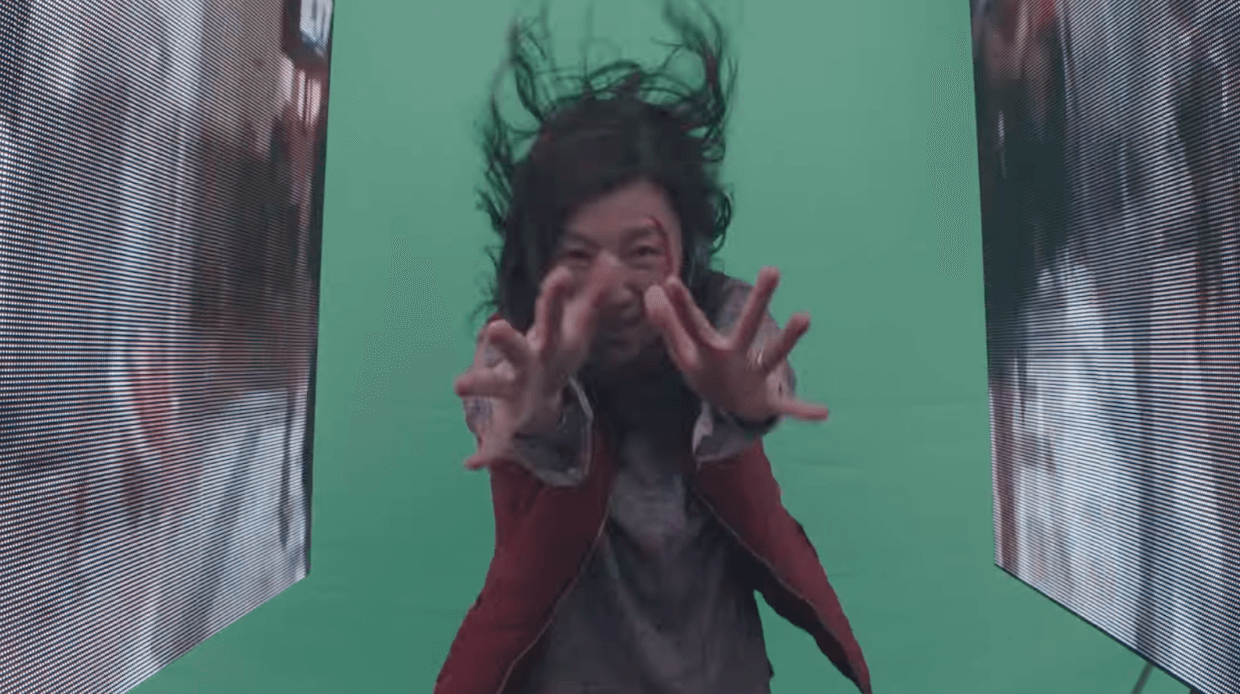 Behind the scenes shot of the verse jump. Image via Wired.
Behind the scenes shot of the verse jump. Image via Wired.
The over-the-top teppanyaki scene where the chef is being controlled a la Ratatouille is another clever example of using 2D effects. As his first task on the job, Desom was asked to create this shot. Since the scene was filmed with the actor pantomiming a teppanyaki chef, Desom had to add food items that reacted to the motions of the chef. He explains that he could have achieved this by using 3D rendering software to add the items and make them behave like real-world objects via the physics engine. However, he decided it would be easier if he used hand-drawn assets that he could hand track because it would be faster than doing it in 3D, and it would give him more control to match the fast pace of the actor’s movements.
To do this, he added a few shapes that resembled the vegetables, and then he drew on lines, highlights, and shadows to make them look believable. After that, he placed the vegetables over the footage and animated their movement manually by adding keyframes to dial in the objects’ trajectory. This allowed him to time precisely when and where each object would be.
 All the lines, highlights, and shadows on this onion were hand-drawn. Image via Jeff Desom (Instagram).
All the lines, highlights, and shadows on this onion were hand-drawn. Image via Jeff Desom (Instagram).
.png?width=1224&name=Screen%20Shot%202022-08-01%20at%205.25.31%20PM%20(1).png) The full trajectory of each vegetable, with each point along the arcs representing a keyframe. Image via Jeff Desom (Instagram).
The full trajectory of each vegetable, with each point along the arcs representing a keyframe. Image via Jeff Desom (Instagram).
The trajectory of the vegetables maybe doesn’t adhere to the principles of physics, but it looks great — Desom highlighted the use of motion blur to make the movement appear more real. The farfetched movement works here because of the silliness of this particular scene.
Using hand-drawn 2D effects wasn’t always the quickest way to do a shot, but the budget was stretched so tight because of the 500+ shots that it was sometimes the only way. Ethan Feldbau told Digital Trends about one particular shot of the IRS building that he created on Photoshop by using a technique called matte painting. A matte painting is a visual effect that’s typically used as a background, with certain parts of the background masked out and replaced. When filmmakers want to alter the background by replacing the sky, removing buildings, or adding new objects, a matte painting is an affordable way to get it done. For EEAO, Feldbau added extra floors to the one-story building, making it appear as if the IRS building in the film is 5 stories tall. He also replaced the sky and everything else above the first floor when the camera pans upward.
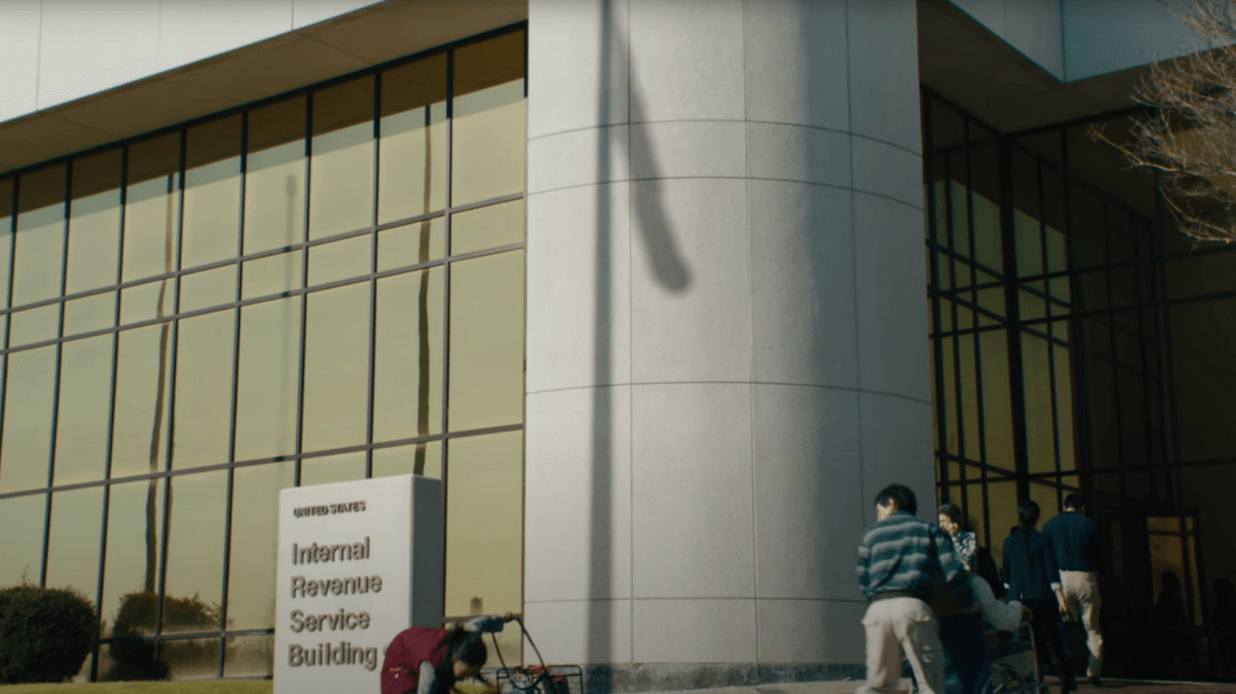 This is the first and only floor of the actual building. Image via Everything Everywhere All at Once (A24).
This is the first and only floor of the actual building. Image via Everything Everywhere All at Once (A24).
 Feldbau’s matte painting of this scence includes extra floors and a different sky. Image via Everything Everywhere All at Once (A24).
Feldbau’s matte painting of this scence includes extra floors and a different sky. Image via Everything Everywhere All at Once (A24).
This technique might have save the team money, but it wasn’t. That shot took him three days to complete. It would have taken less time if a VFX studio had been contracted to a 3D render, but one of the silver linings of the pandemic was the extra time they had to work on the film. But the lockdown also made it hard to shoot additional scenes after principal photography had wrapped.
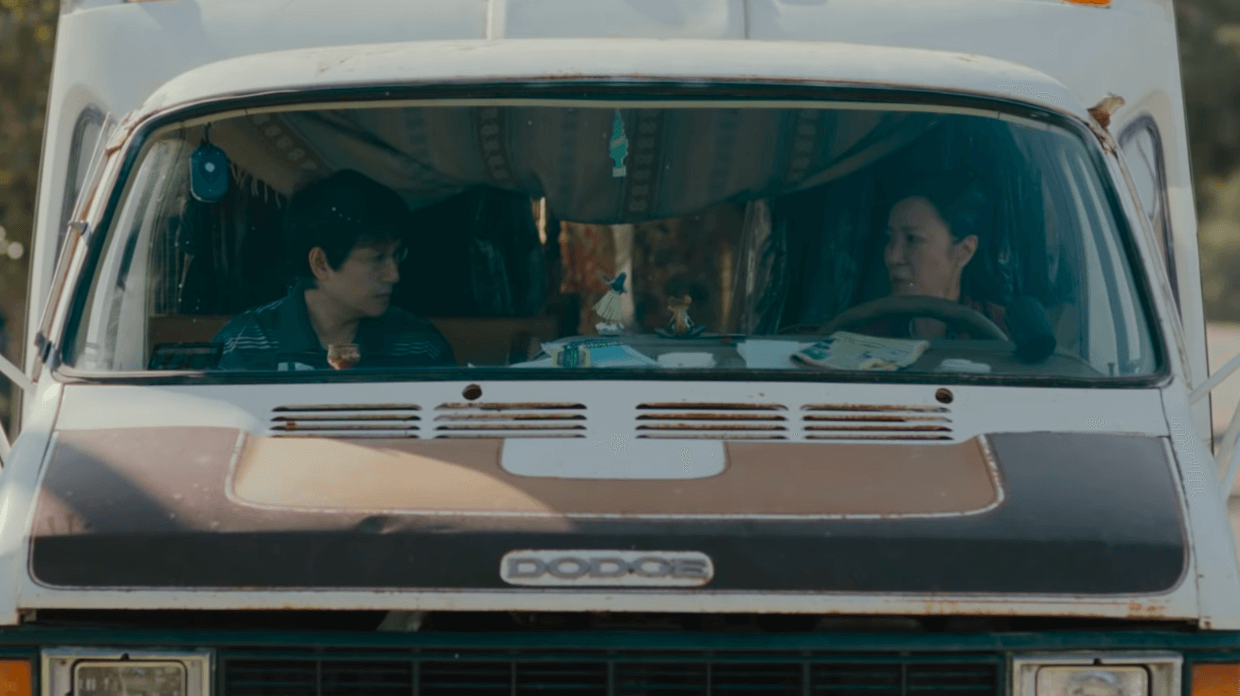 Image via Everything Everywhere All at Once (A24).
Image via Everything Everywhere All at Once (A24).
The scene above where Evelyn and Waymond are finally having their heart-to-heart about their relationship was filmed during the pandemic. It looks like a normal shot; two people are sitting side-by-side in a car having a conversation, except the two actors filmed their parts separately from different sets. Yeoh had to film her scene in Paris on a green screen, where she worked with a local crew that Daniels directed via Zoom. Her shot was later composited onto the one with Ke Huy Quan, who plays Waymond Wang — the scene also featured Scheinert’s hotdog glove-wearing hand.
Doing a Lot With a Little
Daniels and their all-star VFX team deserve all the credit that’s been heaped on them. EEAO is sure to sweep during awards season, and if not, the VFX work will continue to be referred to for years to come. Undoubtedly, Daniels’ work will be an inspiration for any aspiring filmmaker worried about not having the right equipment or enough budget to make their first short film. EEAO is proof that big budgets aren’t necessarily required to make big movies.
 A screenshot of the VFX’s zoom call was slipped in during a montage in the film. Image via Reddit (australiughhh).
A screenshot of the VFX’s zoom call was slipped in during a montage in the film. Image via Reddit (australiughhh).
Thinking outside the box, being resourceful, and executing your vision by being hands-on are what made the movie happen. And despite the low-budget DIY approach, the effects don’t look cheap; they’re stylized. With so many special effects and gags, it’s a film that requires at least two viewings to take it all in — this Redditor found a cheeky easter egg just a few days ago.
Whether it’s a music video, a commercial, or a feature film, Daniels gets the job done. The duo’s reputation for delivering projects that are true to their vision and under budget is well-known. “To this day, I feel like, you could tell them they have $5,000 or $50 million, and if they say yep, they’re going to make something great, just full stop,” said Prettybird’s Brown.

